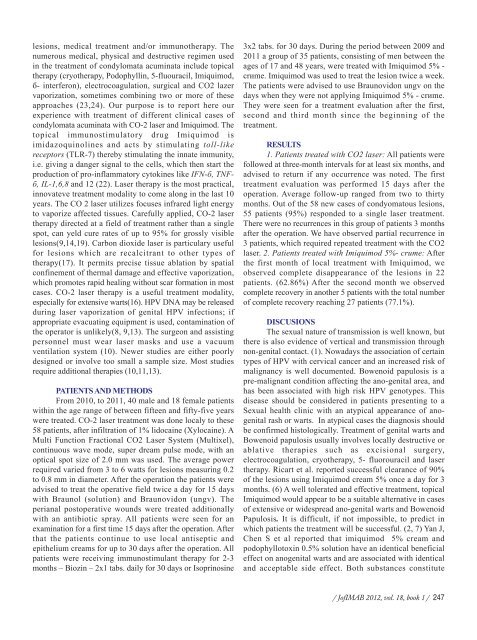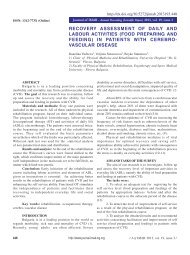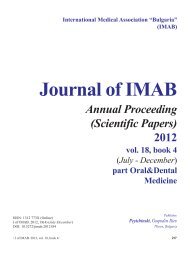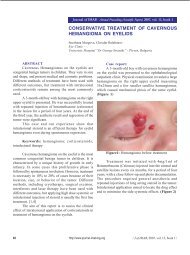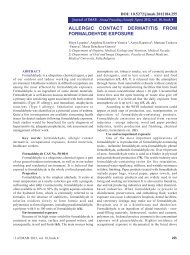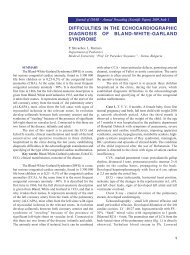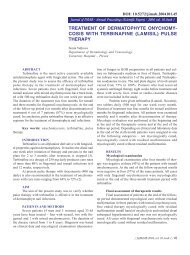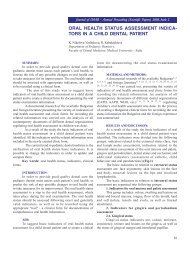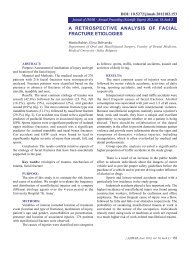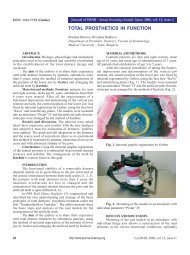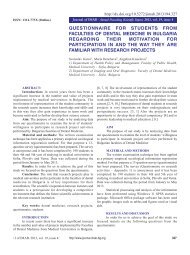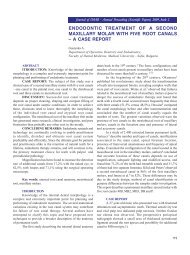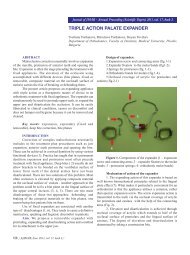treatment of condylomata acuminata and ... - Journal of IMAB
treatment of condylomata acuminata and ... - Journal of IMAB
treatment of condylomata acuminata and ... - Journal of IMAB
Create successful ePaper yourself
Turn your PDF publications into a flip-book with our unique Google optimized e-Paper software.
lesions, medical <strong>treatment</strong> <strong>and</strong>/or immunotherapy. The<br />
numerous medical, physical <strong>and</strong> destructive regimen used<br />
in the <strong>treatment</strong> <strong>of</strong> <strong>condylomata</strong> <strong>acuminata</strong> include topical<br />
therapy (cryotherapy, Podophyllin, 5-fluouracil, Imiquimod,<br />
á- interferon), electrocoagulation, surgical <strong>and</strong> CO2 lazer<br />
vaporization, sometimes combining two or more <strong>of</strong> these<br />
approaches (23,24). Our purpose is to report here our<br />
experience with <strong>treatment</strong> <strong>of</strong> different clinical cases <strong>of</strong><br />
<strong>condylomata</strong> <strong>acuminata</strong> with CO-2 laser <strong>and</strong> Imiquimod. The<br />
topical immunostimulatory drug Imiquimod is<br />
imidazoquinolines <strong>and</strong> acts by stimulating toll-like<br />
receptors (TLR-7) thereby stimulating the innate immunity,<br />
i.e. giving a danger signal to the cells, which then start the<br />
production <strong>of</strong> pro-inflammatory cytokines like IFN-á, TNFá,<br />
IL-1,6,8 <strong>and</strong> 12 (22). Laser therapy is the most practical,<br />
innovateve <strong>treatment</strong> modality to come along in the last 10<br />
years. The CO 2 laser utilizes focuses infrared light energy<br />
to vaporize affected tissues. Carefully applied, CO-2 laser<br />
therapy directed at a field <strong>of</strong> <strong>treatment</strong> rather than a single<br />
spot, can yeld cure rates <strong>of</strong> up to 95% for grossly visible<br />
lesions(9,14,19). Carbon dioxide laser is particulary useful<br />
for lesions which are recalcitrant to other types <strong>of</strong><br />
therapy(17). It permits precise tissue ablation by spatial<br />
confinement <strong>of</strong> thermal damage <strong>and</strong> effective vaporization,<br />
which promotes rapid healing without scar formation in most<br />
cases. CO-2 laser therapy is a useful <strong>treatment</strong> modality,<br />
especially for extensive warts(16). HPV DNA may be released<br />
during laser vaporization <strong>of</strong> genital HPV infections; if<br />
appropriate evacuating equipment is used, contamination <strong>of</strong><br />
the operator is unlikely(8, 9,13). The surgeon <strong>and</strong> assisting<br />
personnel must wear laser masks <strong>and</strong> use a vacuum<br />
ventilation system (10). Newer studies are either poorly<br />
designed or involve too small a sample size. Most studies<br />
require additional therapies (10,11,13).<br />
PATIENTS AND METHODS<br />
From 2010, to 2011, 40 male <strong>and</strong> 18 female patients<br />
within the age range <strong>of</strong> between fifteen <strong>and</strong> fifty-five years<br />
were treated. CO-2 laser <strong>treatment</strong> was done localy to these<br />
58 patients, after infiltration <strong>of</strong> 1% lidocaine (Xylocaine). A<br />
Multi Function Fractional CO2 Laser System (Multixel),<br />
continuous wave mode, super dream pulse mode, with an<br />
optical spot size <strong>of</strong> 2.0 mm was used. The average power<br />
required varied from 3 to 6 watts for lesions measuring 0.2<br />
to 0.8 mm in diameter. After the operation the patients were<br />
advised to treat the operative field twice a day for 15 days<br />
with Braunol (solution) <strong>and</strong> Braunovidon (ungv). The<br />
perianal postoperative wounds were treated additionally<br />
with an antibiotic spray. All patients were seen for an<br />
examination for a first time 15 days after the operation. After<br />
that the patients continue to use local antiseptic <strong>and</strong><br />
epithelium creams for up to 30 days after the operation. All<br />
patients were receiving immunostimulant therapy for 2-3<br />
months – Biozin – 2x1 tabs. daily for 30 days or Isoprinosine<br />
3x2 tabs. for 30 days. During the period between 2009 <strong>and</strong><br />
2011 a group <strong>of</strong> 35 patients, consisting <strong>of</strong> men between the<br />
ages <strong>of</strong> 17 <strong>and</strong> 48 years, were treated with Imiquimod 5% -<br />
crème. Imiquimod was used to treat the lesion twice a week.<br />
The patients were advised to use Braunovidon ungv on the<br />
days when they were not applying Imiquimod 5% - crème.<br />
They were seen for a <strong>treatment</strong> evaluation after the first,<br />
second <strong>and</strong> third month since the beginning <strong>of</strong> the<br />
<strong>treatment</strong>.<br />
RESULTS<br />
1. Patients treated with CO2 laser: All patients were<br />
followed at three-month intervals for at least six months, <strong>and</strong><br />
advised to return if any occurrence was noted. The first<br />
<strong>treatment</strong> evaluation was performed 15 days after the<br />
operation. Average follow-up ranged from two to thirty<br />
months. Out <strong>of</strong> the 58 new cases <strong>of</strong> condyomatous lesions,<br />
55 patients (95%) responded to a single laser <strong>treatment</strong>.<br />
There were no recurrences in this group <strong>of</strong> patients 3 months<br />
after the operation. We have observed partial recurrence in<br />
3 patients, which required repeated <strong>treatment</strong> with the CO2<br />
laser. 2. Patients treated with Imiquimod 5%- crème: After<br />
the first month <strong>of</strong> local <strong>treatment</strong> with Imiquimod, we<br />
observed complete disappearance <strong>of</strong> the lesions in 22<br />
patients. (62.86%) After the second month we observed<br />
complete recovery in another 5 patients with the total number<br />
<strong>of</strong> complete recovery reaching 27 patients (77.1%).<br />
DISCUSIONS<br />
The sexual nature <strong>of</strong> transmission is well known, but<br />
there is also evidence <strong>of</strong> vertical <strong>and</strong> transmission through<br />
non-genital contact. (1). Nowadays the association <strong>of</strong> certain<br />
types <strong>of</strong> HPV with cervical cancer <strong>and</strong> an increased risk <strong>of</strong><br />
malignancy is well documented. Bowenoid papulosis is a<br />
pre-malignant condition affecting the ano-genital area, <strong>and</strong><br />
has been associated with high risk HPV genotypes. This<br />
disease should be considered in patients presenting to a<br />
Sexual health clinic with an atypical appearance <strong>of</strong> anogenital<br />
rash or warts. In atypical cases the diagnosis should<br />
be confirmed histologically. Treatment <strong>of</strong> genital warts <strong>and</strong><br />
Bowenoid papulosis usually involves locally destructive or<br />
ablative therapies such as excisional surgery,<br />
electrocoagulation, cryotherapy, 5- fluorouracil <strong>and</strong> laser<br />
therapy. Ricart et al. reported successful clearance <strong>of</strong> 90%<br />
<strong>of</strong> the lesions using Imiquimod cream 5% once a day for 3<br />
months. (6) A well tolerated <strong>and</strong> effective <strong>treatment</strong>, topical<br />
Imiquimod would appear to be a suitable alternative in cases<br />
<strong>of</strong> extensive or widespread ano-genital warts <strong>and</strong> Bowenoid<br />
Papulosis. It is difficult, if not impossible, to predict in<br />
which patients the <strong>treatment</strong> will be successful. (2, 7) Yan J,<br />
Chen S et al reported that imiquimod 5% cream <strong>and</strong><br />
podophyllotoxin 0.5% solution have an identical beneficial<br />
effect on anogenital warts <strong>and</strong> are associated with identical<br />
<strong>and</strong> acceptable side effect. Both substances constitute<br />
/ J<strong>of</strong><strong>IMAB</strong> 2012, vol. 18, book 1 / 247


